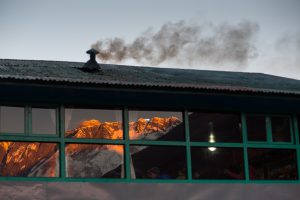
Smoke emitted from a hotel in Debuche as the sun sets in Mt. Everest is reflected in the glass of dining room. The smoke comes from the heating system for the dining room. A Recent study has shown that black carbon from such smoke is also cause for the faster retreat of glaciers in Himalaya Region. Solukhumbu District, Nepal. (Image by Nabin Baral)
The last 12 months have marked significant progress in global renewable energy development, but the world’s most critical region is being ignored. Bold financial innovation is required by the world’s largest asset managers to put the Himalayas on the map.
By Matthew Ribeiro-Norley
Progress in renewable energy development last year was impressive – in October renewables overtook coal as the world’s largest source of power capacity, a milestone in the world’s ambition to phase out hydrocarbons. November marked the Paris Climate Deal coming into force, its flagship commitment aiming to hold global temperature rises within 2 degrees Celsius. Additionally, this January in Davos, the global elite bracketed the failure of climate change adaptation and mitigation as a top 5 risk to the world, alongside weapons of mass destruction.
But contrary to conventional wisdom, the proliferation of renewable energy is not an isolated product of COP 21. Rather, it has been made possible thanks to three independent, but converging trends:
1: The commercial viability of renewable energy against conventional alternatives;
2: Technological advancements in efficiency;
3: Continued pressure from civil society.
This phenomenon coupled with global political will certainly marks a turning point. However, to date the major renewable energy success stories have come out of Western European countries like Germany and Portugal, North America and China. The stories from South Asia – such as they are – have largely glossed over the Himalayan region, where hydropower dams have run into repeated problems.
The Crisis
Few would expect the Himalayas to be battling a localised environmental crisis when it is, in fact, the region with the world’s highest concentration of black carbon (BC) – a strongly light-absorbing component of particulate matter, formed by the incomplete combustion of fossil fuels, biofuels, and biomass.
“Whereas climate change on a global scale is driven by Greenhouse gases (GHGs), there are indications in the Hindu Kush Himalayan region that absorbing aerosols containing large amounts of black carbon are playing dominant role in changing the region’s climate,” states a 2013 report by the International Centre for Integrated Mountain Development (ICIMOD).
The burning of black carbon is accelerating glacial melt and disturbing weather patterns in the Himalayas which have led to extreme droughts and flooding, the report went on to say. According to NASA, the black soot concentration in the Himalayas has increased three-fold in the last 20 years.

Fig I: Concentration of black carbon (micrograms/m2/year)
Unlike the impacts of CO2 which can take several years to manifest themselves, the aftermath of black carbon sequestration caused by fossil fuel combustion and the burning of biomass, is immediate, holding a warming impact on climate 460-1500 times stronger than CO2.
Today, 65% of India’s electricity generation in its northern states is coal-driven, whereas hydro only accounts for 12%. Rising capacity of fossil-fuel fired electricity generation in India, particularly from coal, by far the dirtiest source (coal emits twice the amount of CO2 to diesel and three times that of natural gas), is deepening the crisis.
These numbers contrast sharply with the region’s proven hydro and solar potential of 500 and 1,290 GW respectively – which if successfully tapped could supply the equivalent to that of Germany’s and China’s electricity supply combined. At present, only about 6% of the commercially viable renewable potential in the surrounding Himalayas has been developed.
In addition to the environmental damage, the human threat is stark. Over 600 million people live immediately downstream in Nepal, Pakistan, Bangladesh and surrounding Indian states – 168 million of which are in extreme poverty and 310 million without access to grid electricity. It is one of the most concentrated clusters of poverty on earth.
In India, few argue against coal as it is a cheap dispatchable source of fuel and therefore a better option to developing riskier renewable projects – be it hydro, solar or the wind. Despite India’s ratification of COP 21, it can quite convincingly – and reasonably – justify its need for coal as the cheapest way out of poverty. While there have been positive developments in the Indian solar space lately, the U.S Energy Information Administration (EIA) predicts that India’s generation will be dominated by coal-fired electricity for the next 30 years.
Silver Linings
Admittedly there has been some recognition of the problem – in 2015 the Asian Development Bank (ADB) pledged $6 billion for climate change mitigation and adaptation in the Asia Pacific region. Climate finance vehicles like the Green Climate Fund (GCF) designed to channel soft capital (often grants or investments with less stringent demands on returns) into such projects in developing countries have also helped to add another layer of reassurance. Unfortunately, with added layers of bureaucracy not helped by civil servants involved in the approval process with limited capacity to digest the bigger picture. This has, and will continue to stop promising ground-up adaptation and mitigation initiatives in their stride.
Energy Infrastructure Gap
Traditionally, infrastructure projects in developing countries are financed by the usual suspects: multilateral and bilateral donors, local banks, and development finance institutions (DFIs). While there is nothing wrong with the established order, they come short in filling the infrastructure gap required.
For example, Nepal alone needs USD 20 billion of investments in power development if it intends to match growing demand, expected to reach 10,000 MW by 2030[iv]. The domestic capital market is limited to about USD 4 billion, leaving an additional FDI financing requirement of USD 16 billion, or USD 1.2 billion a year. This may sound reasonable and within the limits for most developing countries, yet Nepal’s FDI inflows in 2016 stood at just USD 54 million. Put differently, it would take the country 300 years to finance 10,000 MW of power in the current financial climate.
A Window of Opportunity
The only investor category with a shot of coming close to addressing this capital gap are institutional investors, collectively, they hold USD 25 trillion in assets under management – 10 times that of South Asia’s GDP in 2016.
While it might have previously been absurd for an institutional investor to consider a country like Nepal – which holds no sovereign rating – it might indeed be possible thanks to a few reasons: low bond yields in developed economies, increasing restrictions in investment mandates for fossil-fuel plants, top-down post COP21 sentiment and bottom-up pressure from a growingly conscientious middle class in Europe and North America.
A fifth and crucial development has also been the proliferation of bilateral climate funds providing grants and soft loans to facilitate projects otherwise considered unviable in risky markets. Instruments such as a First Loss Reserve can be used to absorb potential losses in order to make a project viable.
Just last month the Netherlands’ largest pension fund – APG – committed USD 132 million to an Indian developer’s solar platform. Similarly, Canada’s second largest pension fund – Caisse de Dépôt – invested USD 150 million to a solar power project in Gujarat, India – others will follow suit. A single institutional investor intervention in a renewable energy project in Nepal would set a precedent and open the door for other capital-hungry sectors.
The alternative for Nepal? Continued dependence on Indian coal-fired electricity imports, which today accounts for nearly half of domestic Nepalese consumption, and the resulting compounding of the black carbon crisis. The country’s ability to begin developing its 43,000 MW hydro potential is critical not only for its own development in achieving energy independence but for the environmental stability of the Himalayan-Hindu Kush region.
Final Words
The answer to addressing the unfolding black carbon crisis in the Himalayas lies in a bold initiative driven by financial innovation. Blending concessional green finance with commercial capital would provide a robust approach allowing commercial investors to make reasonable returns while drastically enhancing environmental and social targets set out by green energy funds. Put simply, it is a solution that would render investments attractive to previously untapped sources of finance. Bridging these two realities would not only lay the foundations to plug Nepal’s – and indeed the region’s – infrastructure gap, it would tackle South Asia’s clean energy deficit head-on.
Matthew Ribeiro-Norley is a Renewable Energy Analyst working with the Dolma Foundation. He can be contacted at: matthew@dolmafund.org
(This article was originally published by the Third Pole. To read the original article click Here)


















